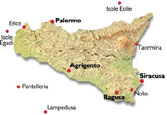 |
 |
|
Megara Hyblaea & Thapsus(SR) | ||
|
||||||||
|
The main road south from Catania to Siracusa is nasty, dangerous and long. In my driving experience only the road from Nairobi north to Nakuru is worse. As you approach the Golfo di Augusta it gets even less pleasant - you now have a view to the left of one of the most polluted bays in the Mediterranean, set off by the turrets, chimneys and pipes of Europe's largest concentration of chemical plants, employing one in ten Sicilians.
Beyond Megara is Augusta, which for years I never managed to reach: on the map it's a sort of mini-Syracuse and allegedly has good restaurants. In 2007 I found it impossible to park, drove round the narrow impossibly congested streets and left immediately. I had no reason to suppose that I'd missed anywhere special. While in this general area, I would however recommend a visit to the peninsula (it really is an "almost-island" being joined most tenuously to the mainland) of Thapsus (now Magnisi - from the Greek for "big island"). Don't be put of when the road becomes a muddy rutted yard seemingly attached to a factory making rusty sheds: it improves again, and eventually you'll end up (just before a gate across the road) at a spot where you can enjoy a fine view across to the petrochemical landscape south of Augusta. Unbelievably you are facing a beach, which is a popular destination for a weekend or evening swim. Even more incredible is the little bay right below you - despite the wasteland around you, it's as beautiful as anywhere in the Mediterranean. Thapsus seems to have been almost if not entirely uninhabited until the Athenians used it as a naval station in their attack on Syracuse early in 414 BC, though a number of tombs dating to around 1000 BC have excavated, many containing objects indicating a flourishing trade with Mycenaean Greece at this time.
|
 |
Use the table below to find your way around Sicily: |  |
||||||||||
| Map | Index | PA | ME | CT | EN | CL | SR | RG | AG | TP | ||
Printer friendly page: click to print
| What's new? | Search the site? | Main Index? | Bookshop? | Top of Page? | ||||
|
The Classics Pages are written and designed
by Comments, questions and contributions welcome. |
||||||||